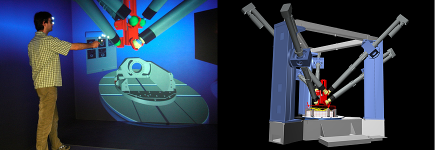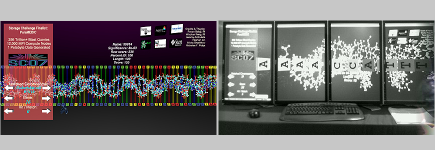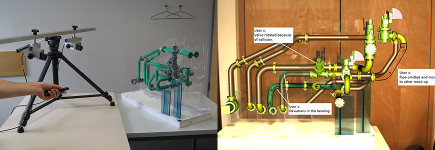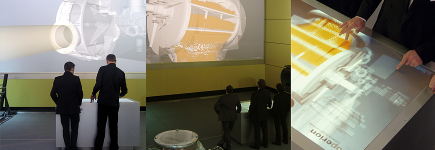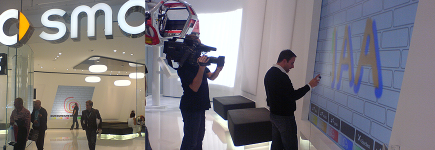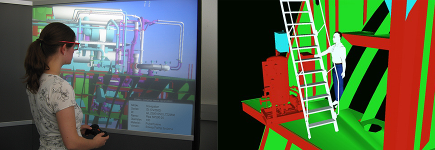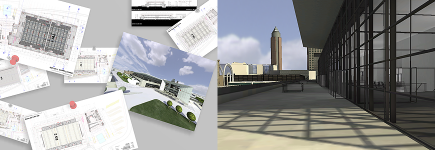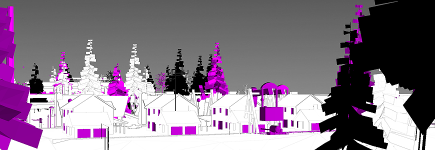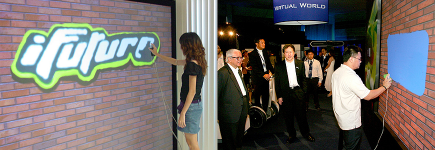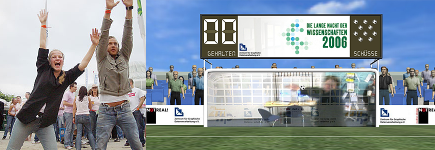VRAx® denotes a platform for designing machine tools that is based on Virtual Reality (VR) technologies analogous to existing CAx tools. VR technology is used as an active development and design medium in this process, and data created in VR are recirculated into the overall development process. Variants of machine tools with parallel kinematics can readily be created by combining a modular approach with free modeling functionality. This reduces the development times of new machine tools by the direct implementation of the customer’s wishes in an immersive environment and with considerably increased transparency of the development process. This is achieved by consistent integration of VR into the development and design process. Starting from a building block system of components of machine tools with parallel kinematics (PKM), functions for freeform modeling and optimizing the machine structure become available.
Archive for January, 2010
VRAx
Thursday, January 21st, 2010ParaMEDIC at SuperComputing 2007
Wednesday, January 20th, 2010Virginia Tech’s ParaMEDIC (Parallel Metadata Environment for Distributed I/O and Computing) won the Storage Challenge at IEEE/ACM International Conference for High Performance Computing, Networking, Storage and Analysis (). ParaMEDIC is a high-performance and portable framework to decouple computation and I/O in applications that require large quantities of both resources simultaneously. The visualization at the Virginia Tech’s Booth was rendered on 4 monitors with instant player and on one monitor in Argonne National Lab’s booth.
Augmented Reality Measuring System
Tuesday, January 19th, 2010In order to identify differences between physical and digital mock-ups, which do not match exactly, and to transfer those differences back into CAD format, we developed an AR based measuring system. The system allows matching the CAD data with real mock-ups and documenting differences between them. Essential functions like measurement and online construction are provided, allowing the end-users to create information in AR space and feeding them back into the CAD model. The application was developed within an authoring tool based on the instant*reality*-framework. Furthermore, it was presented on ISMAR ’07. The tool was developed for the needs of the submarine engineering of (Howaldtswerke – Deutsche Werft GmbH), who also funded the project.
Coperion Visualization at K Fair
Monday, January 18th, 2010We developed together with Design and Systems Institute a technical information visualization based on our multi-touch table and an 8 meter wide HD projection. The complete interactive plastics production process was presented at K trade fair on Coperion group’s (global market leader for compounding systems) booth. It enables users to see and understand complex and invisible processes inside the machines via a simple multi-touch interface.
Virtual Graffiti at the International Automotive Fair (IAA)
Sunday, January 17th, 2010InViS – Integrated Virtual Shipbuilding
Saturday, January 16th, 2010The BMBF-funded project InViS (Integrated Virtual Shipbuilding) aimed at developing innovative tools for the product development and at their integration and introduction in shipbuilding industry. Focus was laid on concepts for integration of Virtual Reality (VR), tele-cooperation and simulation in the product development process. On top of the integration platform the instantreality player was used as tool that provides interactive operation capability to the platform’s services.
Architecture Visualisation – Messe Frankfurt GmbH
Friday, January 15th, 2010To validate the architecture of the planned exhibition halls the Frankfurt Fair is using the instant reality player for interactive exploring the architectural 3-D models. Starting from the architectural 2-D plans a high quality 3-D model of the booth area has been generated by Mainfeld. This model is visualised using the instantplayer within a CAVE environment and on the HEyeWall. Therefore the walk model has been implemented realising intuitive navigation through the VR model. In contrast to the free 3-D flying mode the walk mode avoids the penetration of walls and it supports a walking simulation on floors and stairs. Thus an intuitive navigation algorithm has been implemented that is dedicated to users with no experiences in 3-D computer graphics. Using this architecture visualisation the decision making process of the architecture planning was supported. VR visualisation of architecture has been proofed as a valuable planning tool.
Kaskade
Thursday, January 14th, 2010Kaskade is an interactive, stereoscopic X3D installation visualising parasitic behaviour. Using a WiiMote the user can navigate through a continously reconfiguring landscape made up of a 7×7 grid whose cells are controlled by a modified Game-Of-Life algorithm with four states. Each algorithm state is mapped to one of four visual representations: desert, forest, city and industry. These representations are fully animated for setup and tear down making the landscape an unpredictable, ever-changing world to explore. Using GLSL-Shaders a sketched look was realized. The project was developed as diploma thesis at the CrossMediaLab of the HfG Offenbach.
Virtual Graffiti
Wednesday, January 13th, 2010IGD/CAMTech’s Virtual Graffiti was selected to be exhibited in Singapore Science Centre’s iFuture exhibition from December 2006 to April 2007. During the iFuture Opening on 10 Dec 2006, Guest of Honour, President S.R Nathan and Dr Tony Tan were present to grace the event.
Interactive Goal Keeper
Tuesday, January 12th, 2010The interactive goal keeper-game is a virtual application for audience entertainment to use on exhibitions and on sales promotion. Via camera, the player beomes integrated into the virtual soccer scene. As a goalkeeper, the player has to catch the computer-animated balls. During the game a photo of the player will be taken and printed afterwards including the respective company’s branding.
